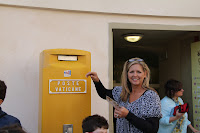Karen the Good/Middle Sister had us at the gate waiting to be admitted into the offices of excavations at the Vatican well in advance of the appointed hour.
She had requested three spots on the Scavi Tour, granted only by special request to a certain few, soon after she learned about the trip. She was beside herself when she learned we were granted a tour.
 The Swiss guards at the gate turned out to be friendly and one of them quite chatty. We conversed with them until the clock struck three and we were allowed into an area normally closed to tourists.
The Swiss guards at the gate turned out to be friendly and one of them quite chatty. We conversed with them until the clock struck three and we were allowed into an area normally closed to tourists.When we entered the Scavi office (to which we had gotten careful directions earlier in the day pursuant to our to do list for the day) we were told we were too late. I thought Karen the Good was going to cry just then. Perhaps it was the stricken look on her face or maybe it was the Baby Sister's explanation that we made haste as soon as we given leave to enter the area by the guards. In any event, the tour was just starting and the assembled group was peering into small models of the Basilica when we were taken beyond the immediate office area.
Other scale models nearby showed the progression of the site through the ages. At first, our guide told us, since theApostle Peter was a criminal when he was buried (after being crucified upside down) his grave was unmarked and known only to his closest followers. Later, those who would make pilgrimage to his place of interment marked it carefully with "grafitti" markings of Christian symbols that would preserve but also protect the site.
Thus the grave of the apostle was protected during many invasions of Rome and the "sacking" of objects d'art, relics, etc. was not exacted upon Peter's burial place. Once Constantine declared Christianity as the official religion of the Roman Empire, an altar was placed at the site. Later, as Christianity gained more of a foothold, a more elaborate altar was erected and ultimately, a church built round about the altar.
Over time the Church grew from the place of a simple grave until today, it is considered to have the largest interior of any Christian church in the world
 Now, all of this we could have read in a guide book or on Wikipedia. , though listening to our young guide explain in her broken accent was charming. And to tell the truth, I kind of wondered why we needed to see any of the excavation sites in the bowels of Vatican City. Having seen the Basilica from ground floor, I was satisfied. But my sister wanted to tour the underside and so I was in. After all, this really was her trip.
Now, all of this we could have read in a guide book or on Wikipedia. , though listening to our young guide explain in her broken accent was charming. And to tell the truth, I kind of wondered why we needed to see any of the excavation sites in the bowels of Vatican City. Having seen the Basilica from ground floor, I was satisfied. But my sister wanted to tour the underside and so I was in. After all, this really was her trip.And so we enbarked on a part of our trip that was certainly one of the most memorable.























